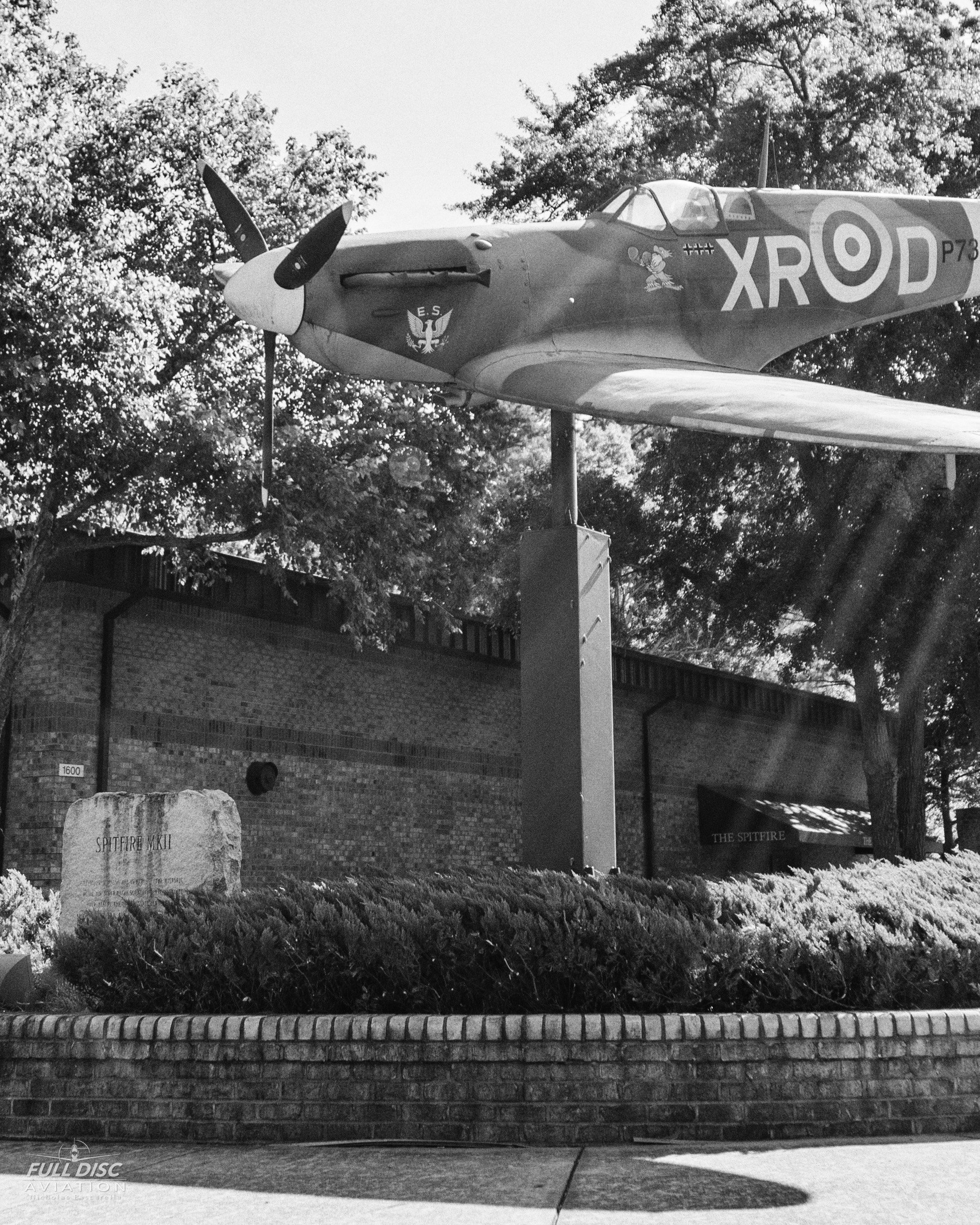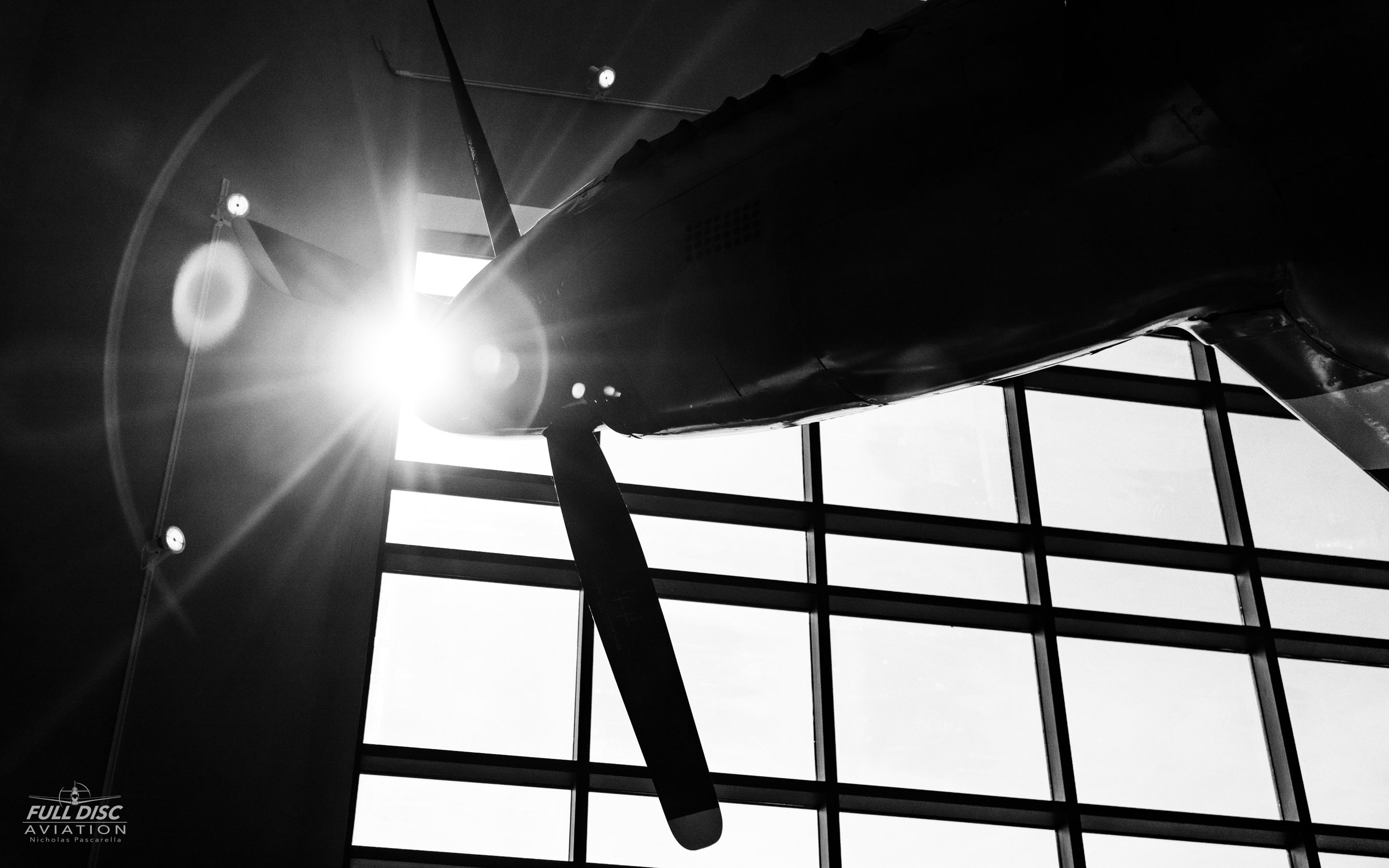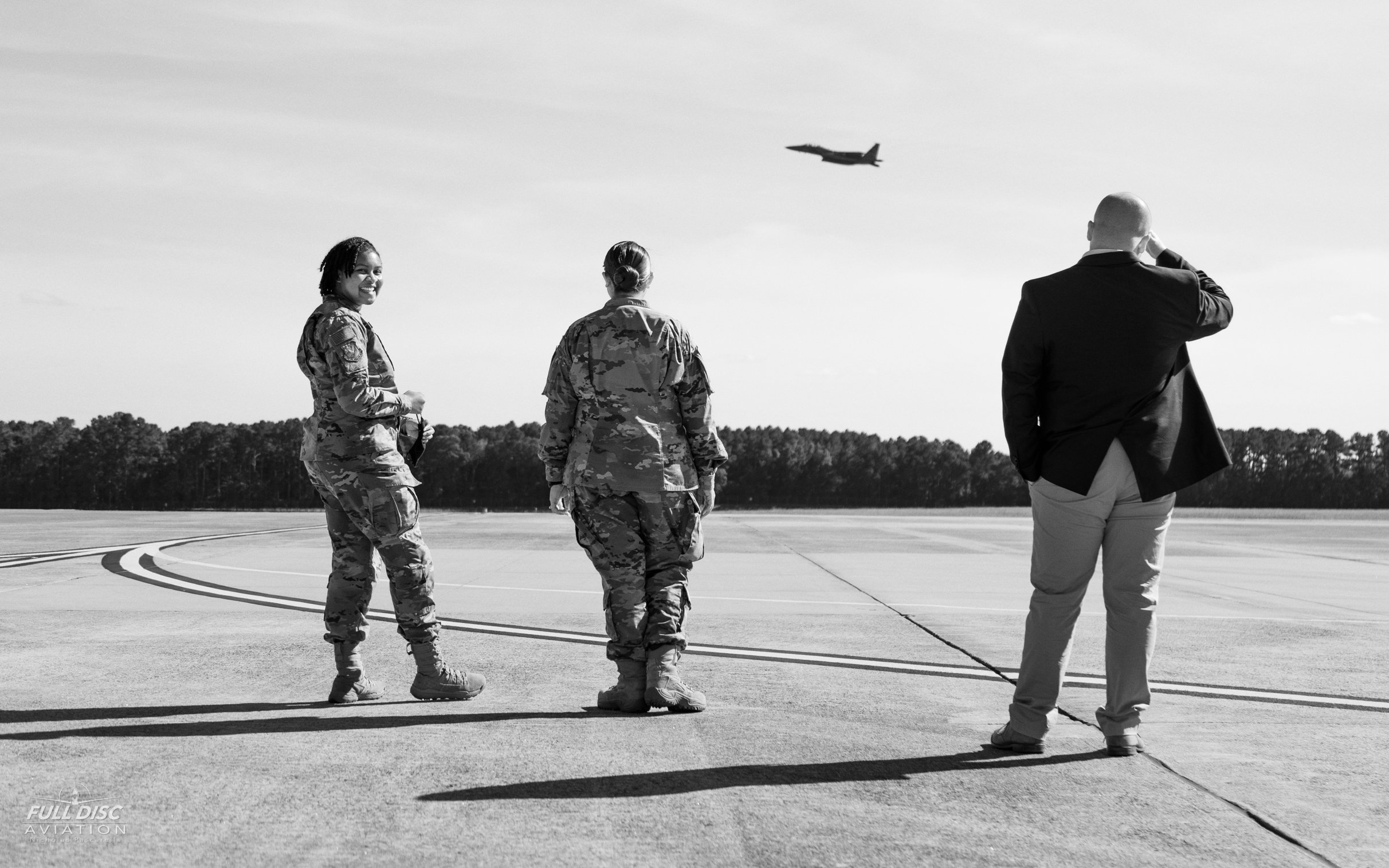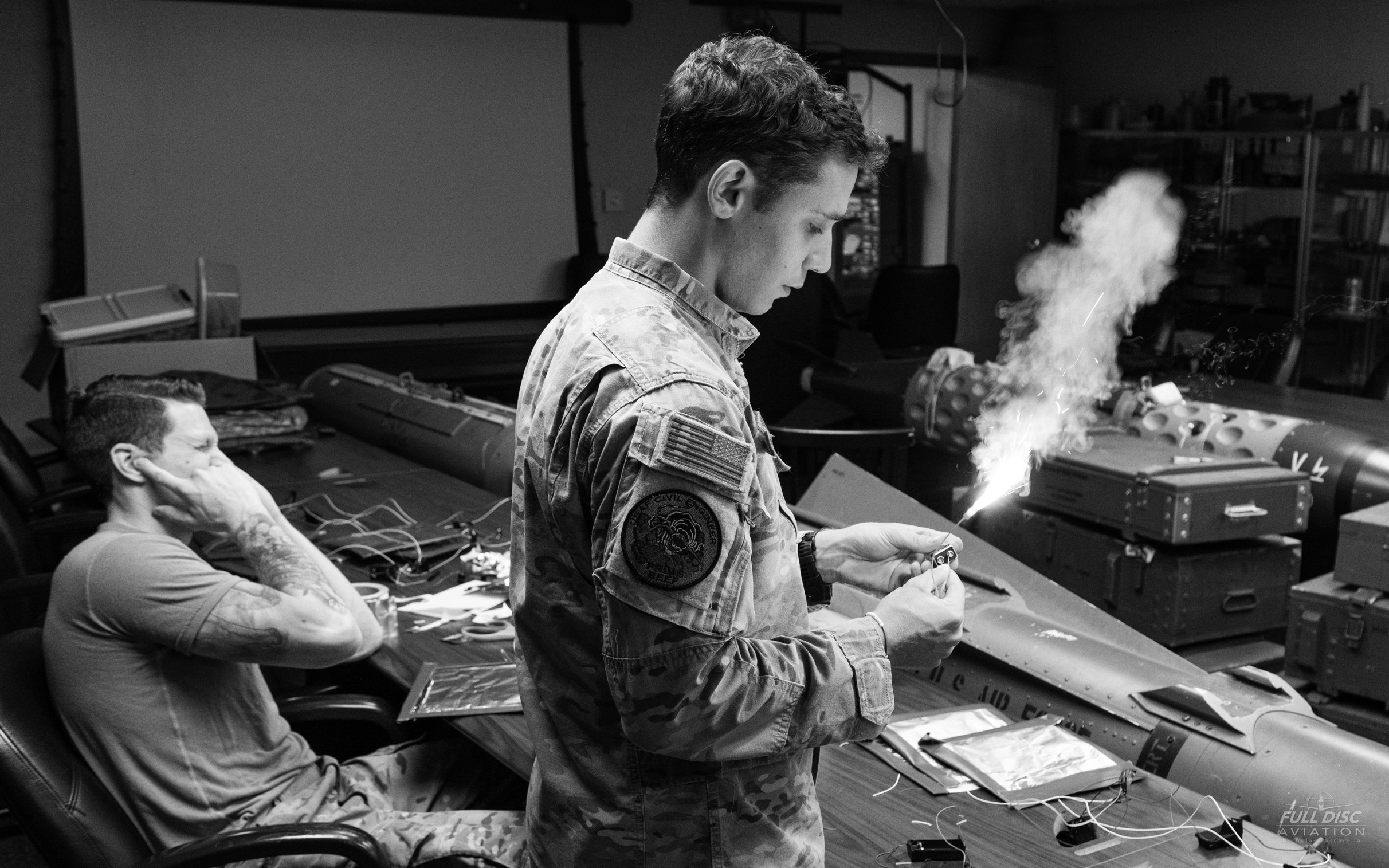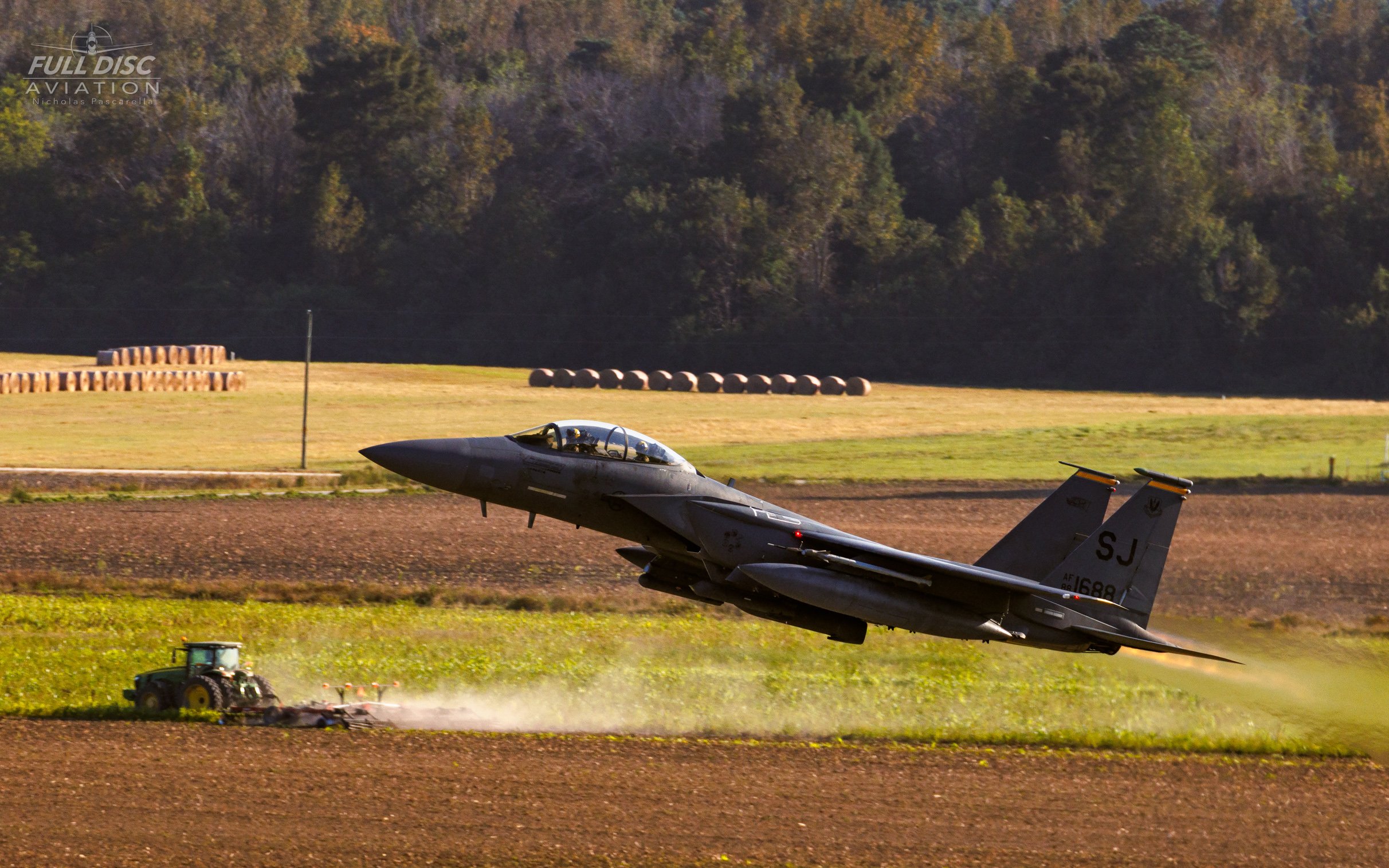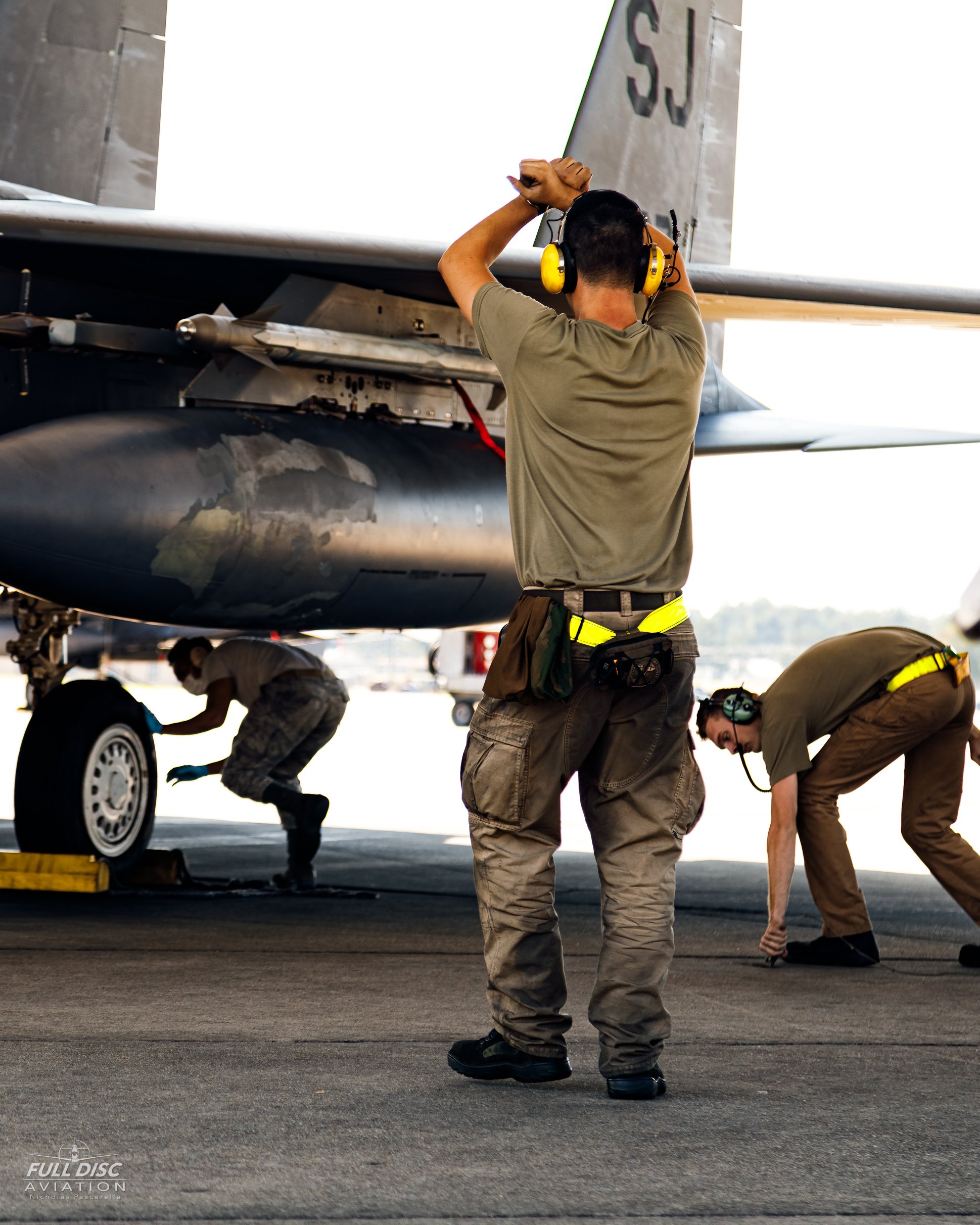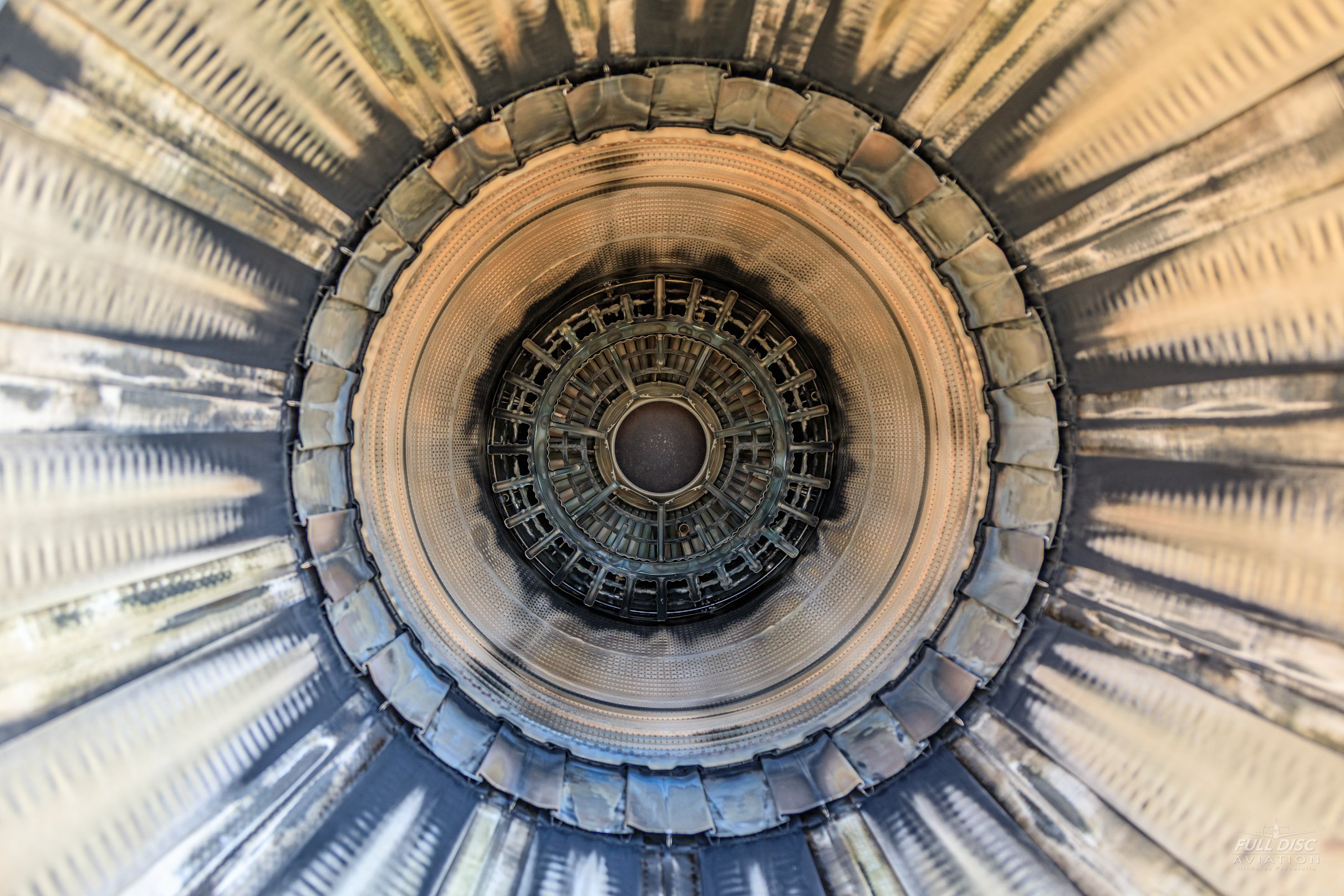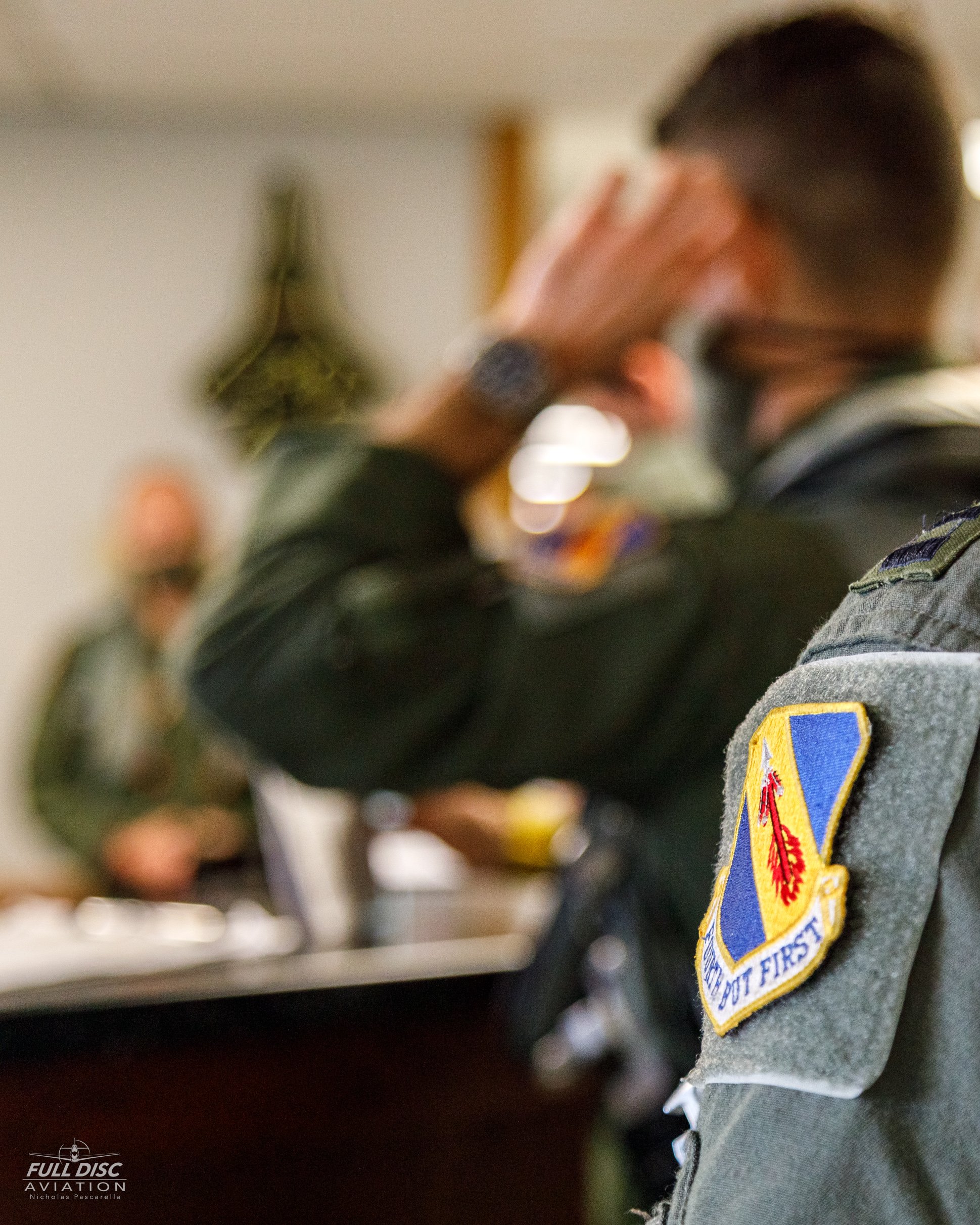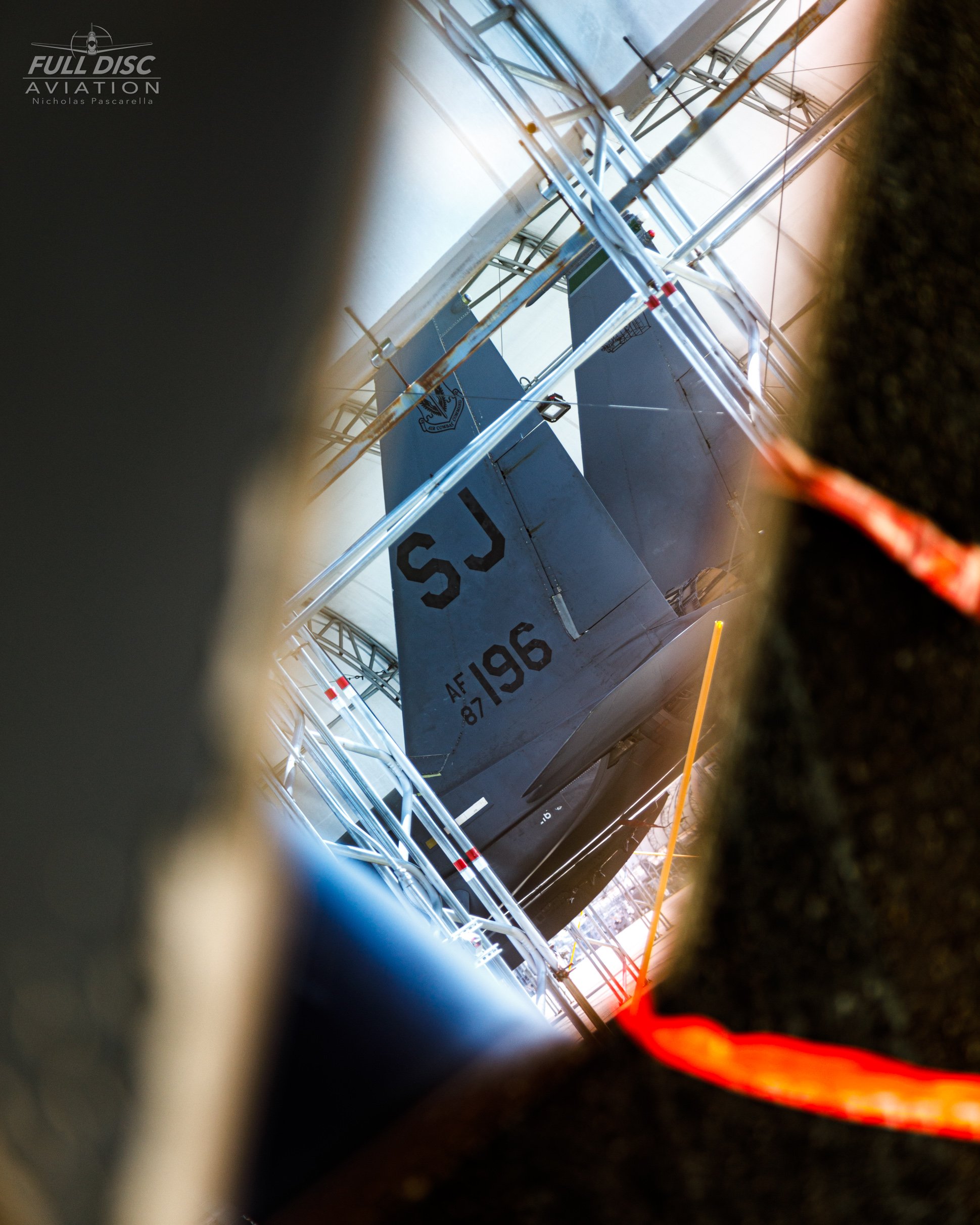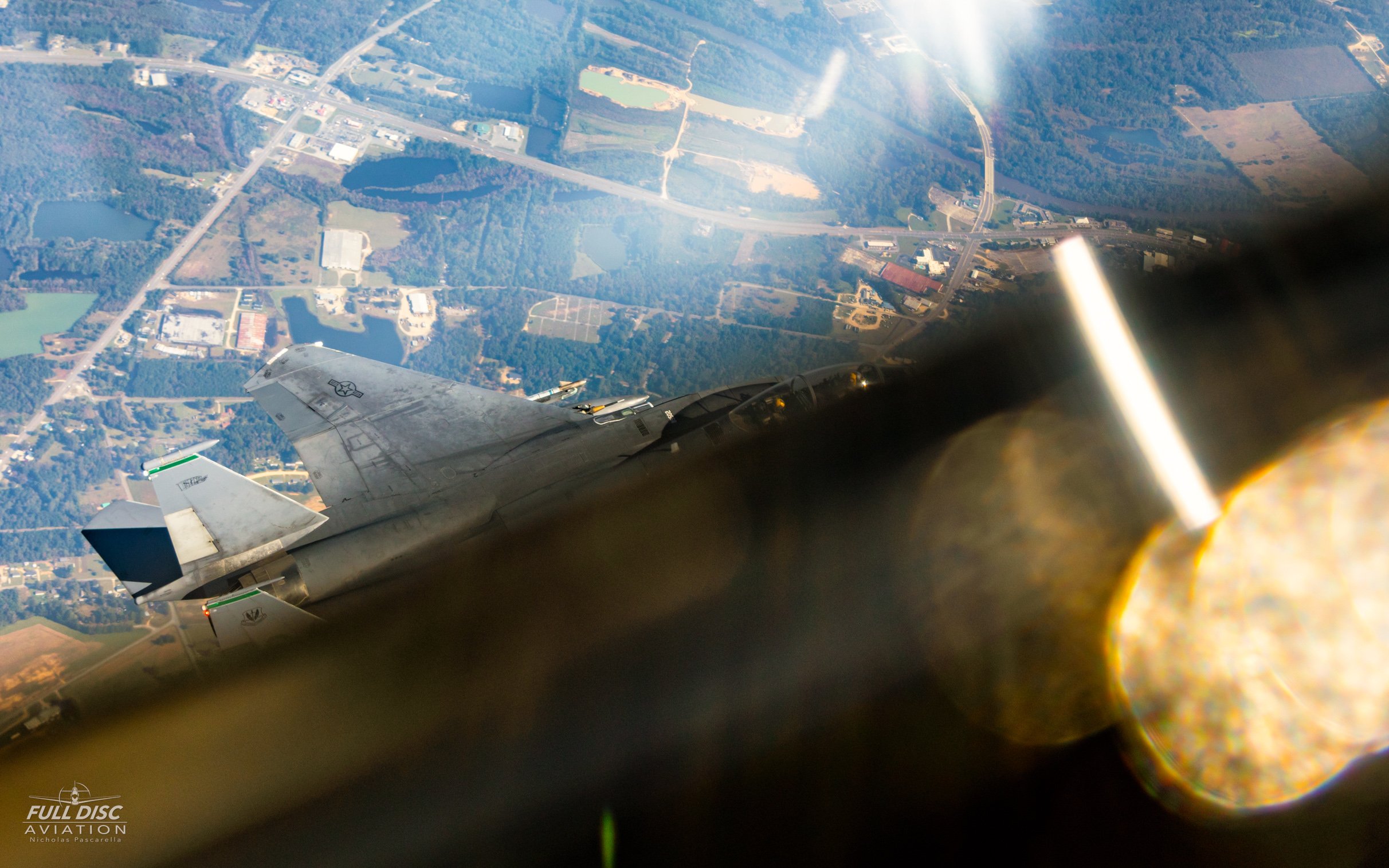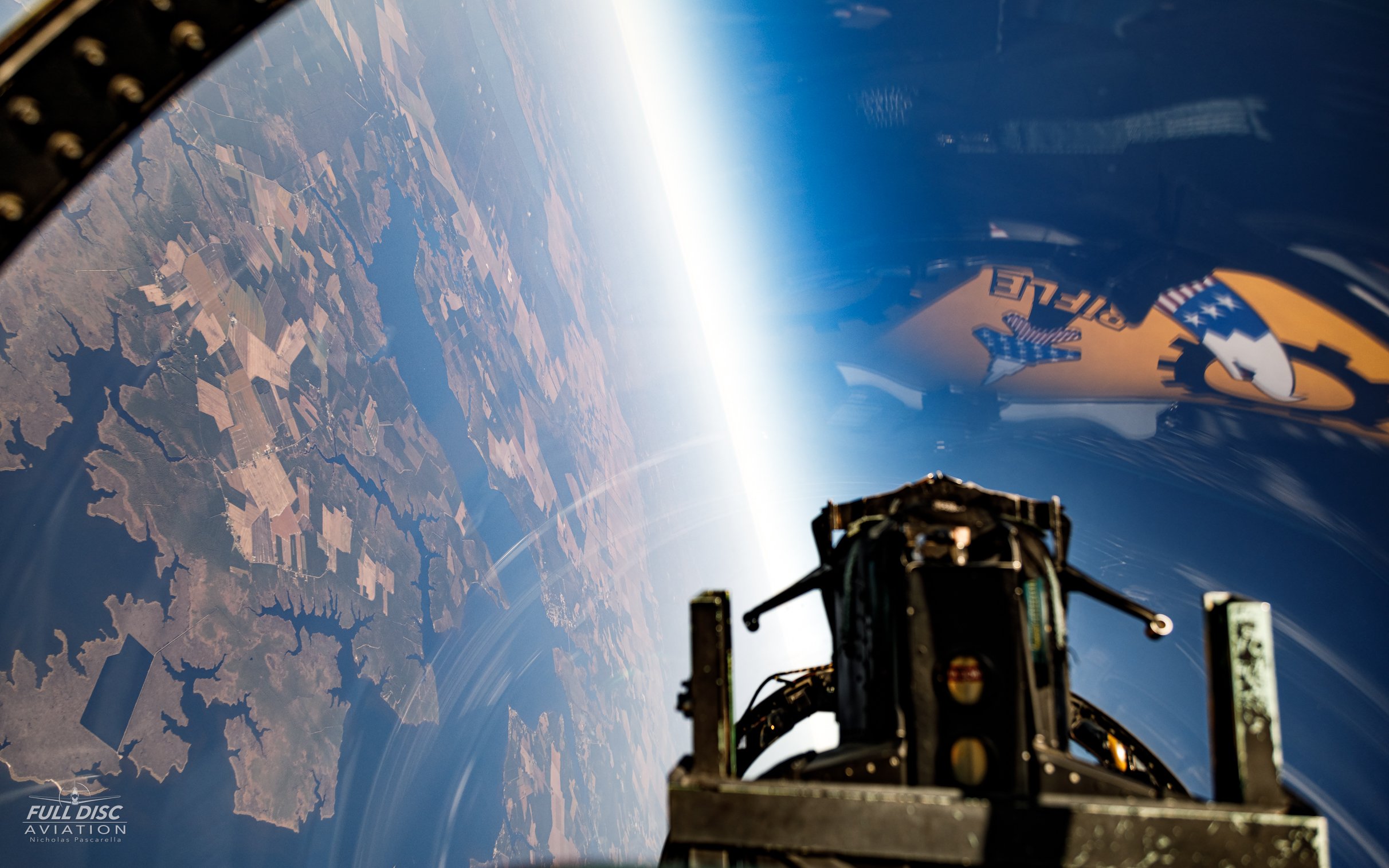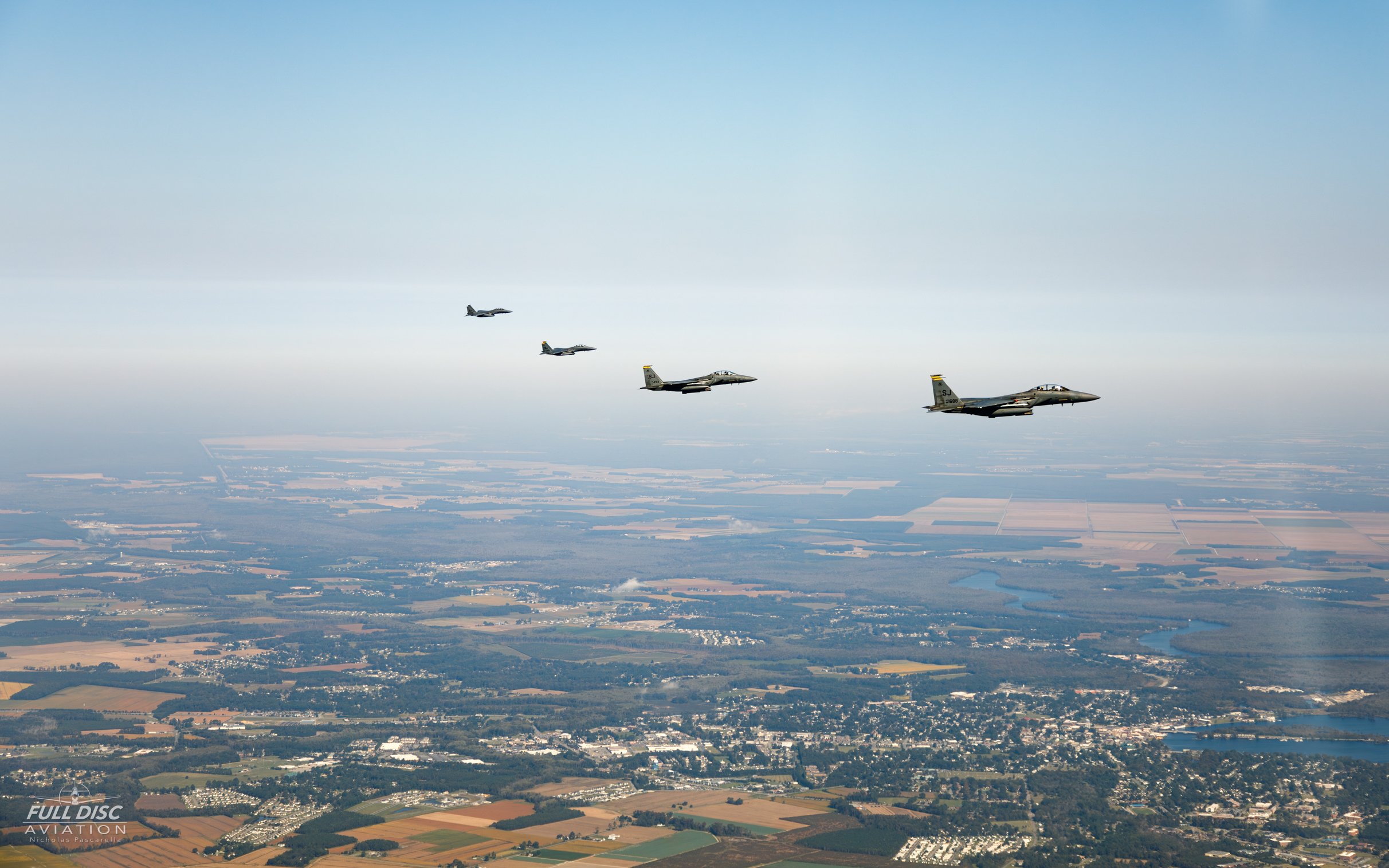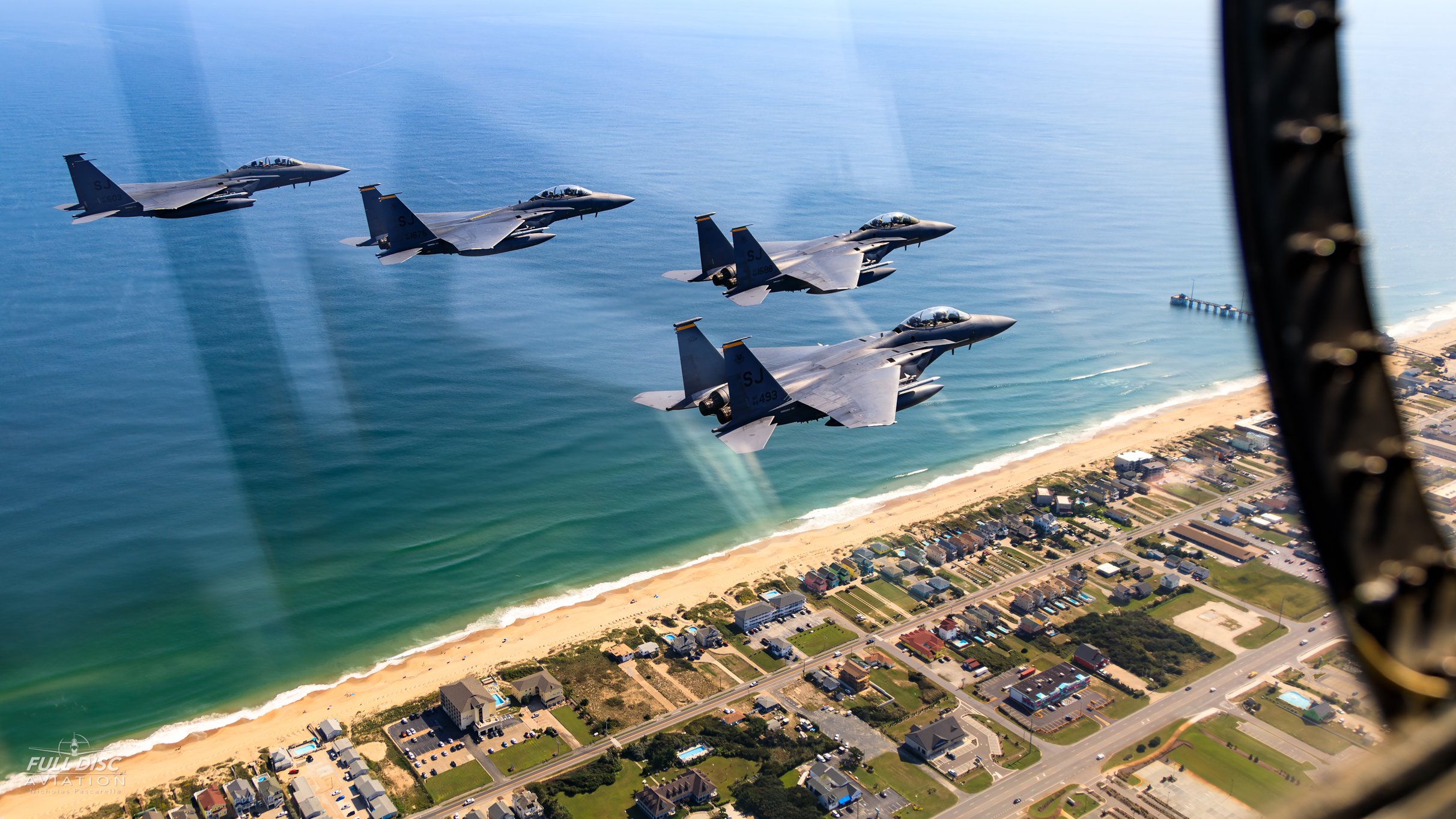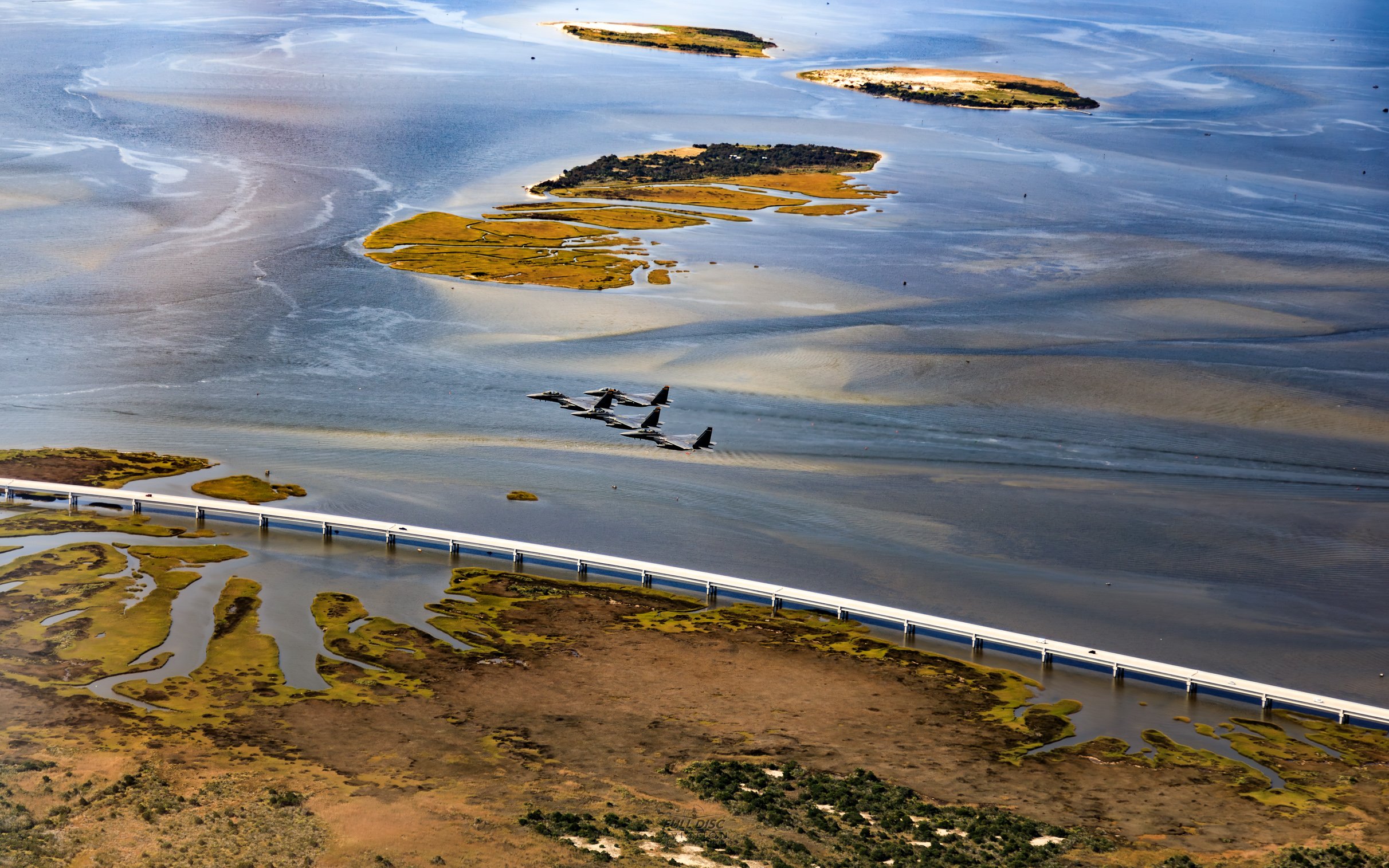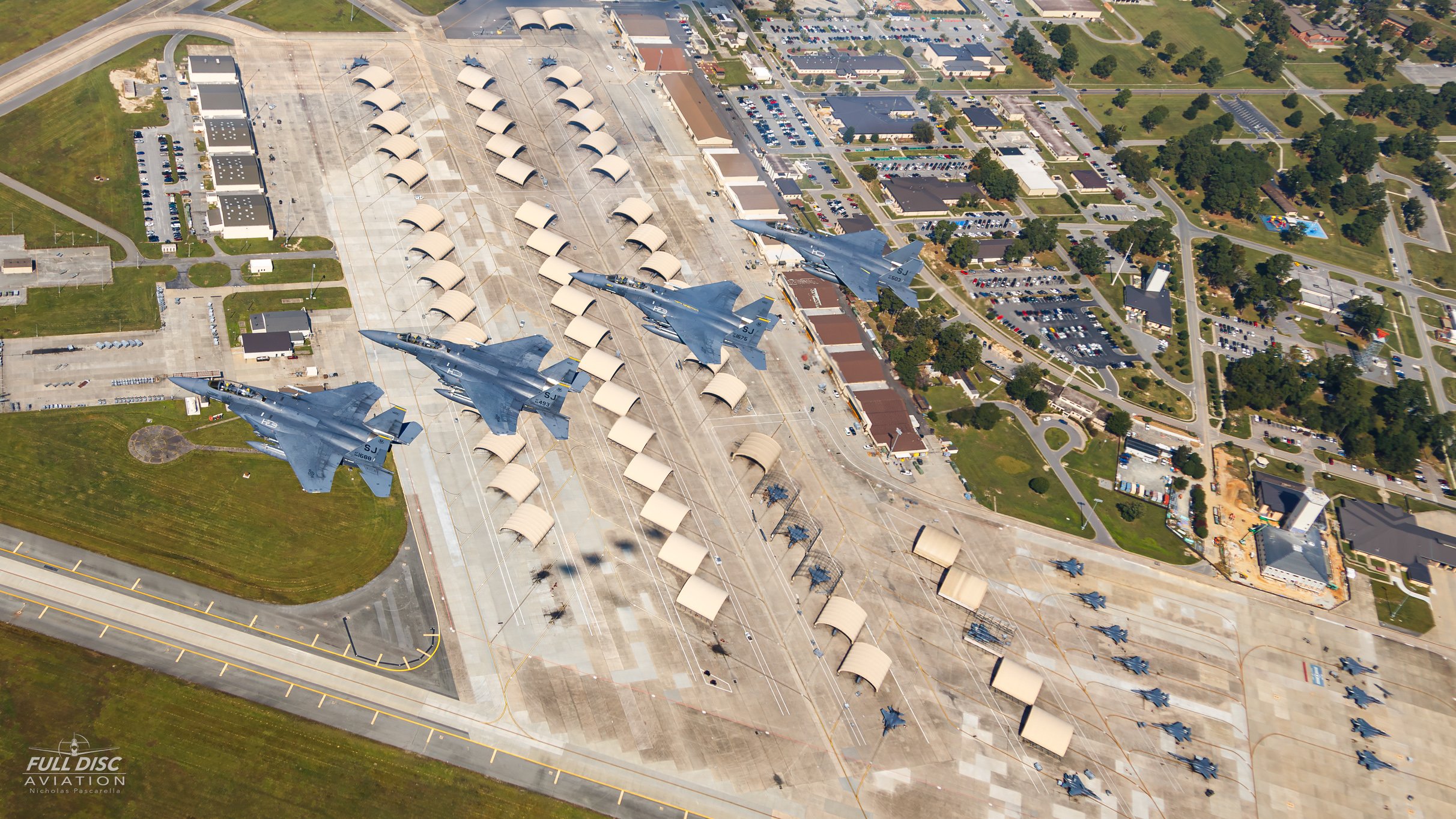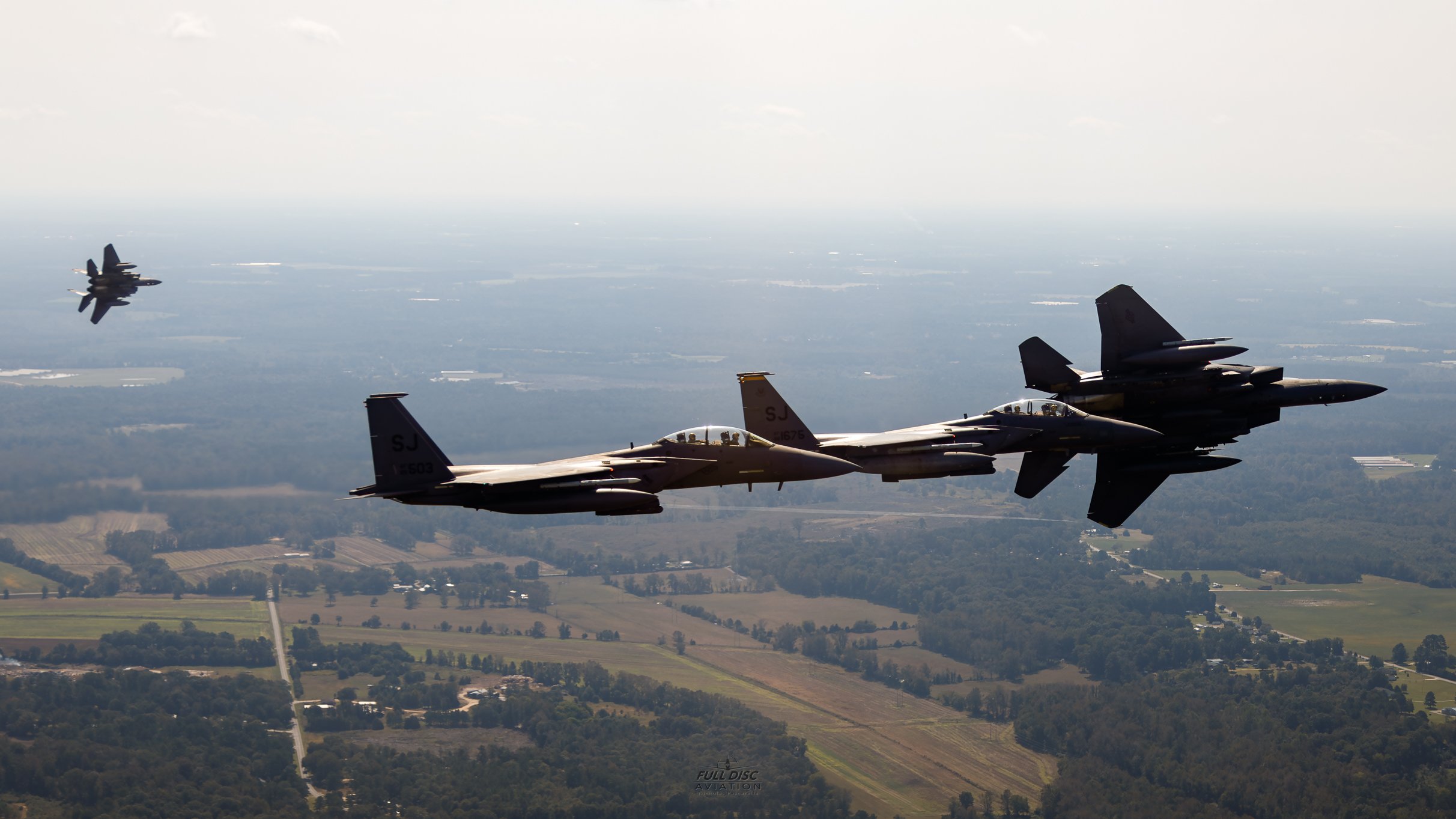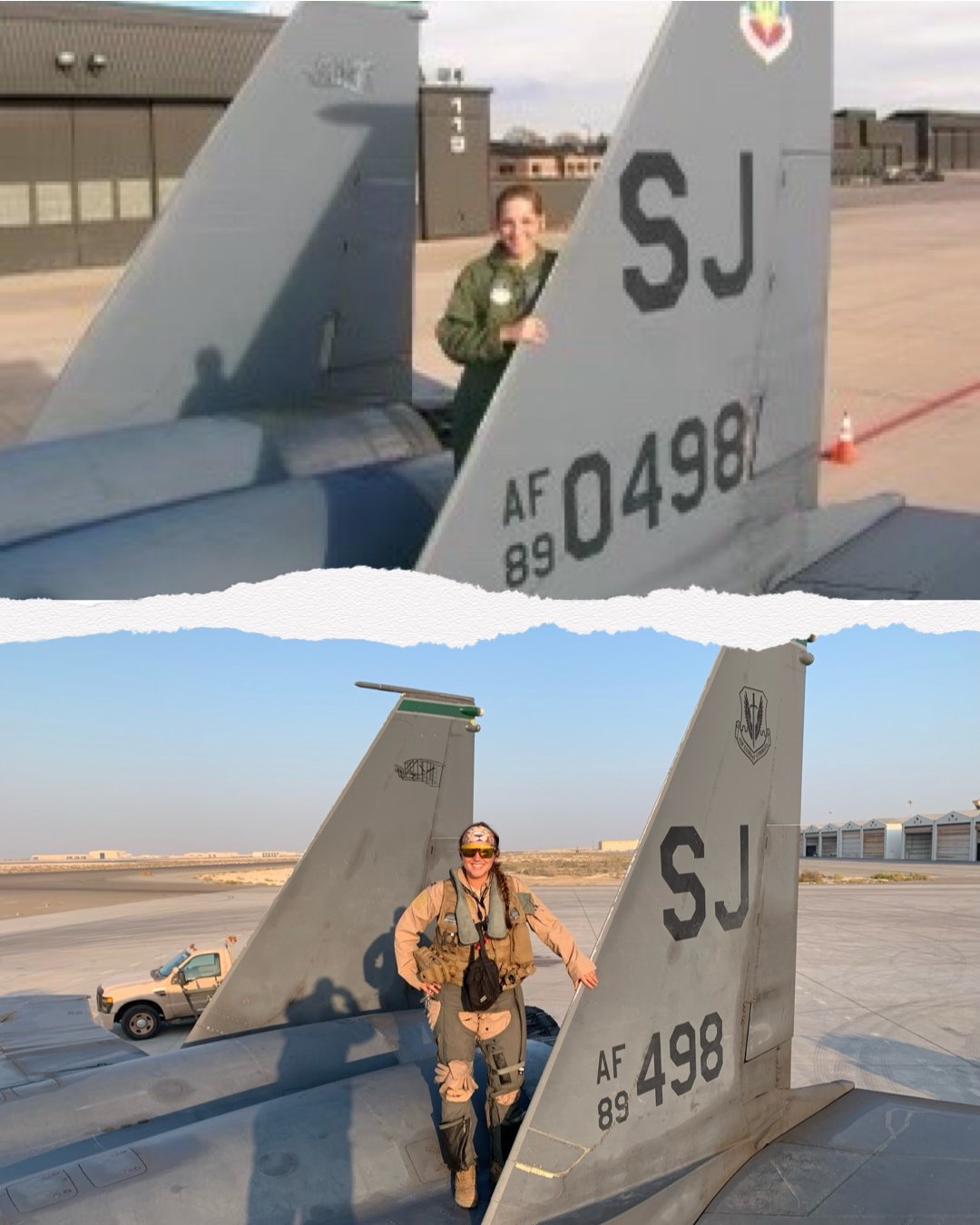Fourth But First
Fourth But First
F O R E W O R D
In October of 2020, I was afforded the honor and privilege of touring the 4th Fighter Wing and Seymour Johnson Air Force Base, joining the legendary 336th Fighter Squadron "Rocketeers" on a flight over the coast. Since then, many of the characters in this piece have moved on to different roles, or out of the military entirely; I've left their details here unchanged. This remains a snapshot of a bustling US Air Force base in a very difficult and specific period in time, and looking back, what was already a rare look inside an operational fighter squadron was made even more so by the circumstances. Though it has been a number of years, the admiration and appreciation for everyone who worked on this piece with me glows just as bright as it did at Mach.
- Nicholas "Scotch" Pascarella
Seymour Johnson AFB
4th Fighter Wing
Seymour Johnson Air Force Base in Goldsboro, North Carolina, is the only USAF base named after a US Navy aviator. Goldsboro native Lieutenant Seymour Johnson lost his life when his F4F Wildcat crashed in March, 1941 during a test flight; the bustling Strike Eagle nest in his hometown now bears his name. On base, a Mk II Spitfire poised diving outside of the aptly named Spitfire Pub is a subtle nod to the deep history here.
The 4th Fighter Wing, stationed at Seymour Johnson AFB, has roots that predate the US Air Force itself. American pilots flew Spitfires in defense of Great Britain for the Royal Air Force before the US officially entered the war. After earning a fearsome reputation, three of these RAF "Eagle Squadrons", No. 71, No. 121 and No. 133 Squadrons, were transferred as a unit to VIII Fighter Command of the USAAF in fall 1942 as the 334th, 335th, and 336th Fighter Squadrons respectively, and the 4th Fighter Group was born. Their feats were just beginning.
The list of "firsts" from the 4th Fighter Group reads like an all-time highlight reel: they were the first fighters to use belly tanks, first to penetrate Germany, first to escort bombers into Berlin, and the first to down an enemy jet fighter. Moving past WWII, they were the first unit to have an all-jet ace, the first unit to operate the F-15E, and the first active USAF unit to be commanded by a female; Col. Jeannie Leavitt.
Near the 4th Wing building, iconic jet fighters from each era of Seymour Johnson are forever climbing over the manicured lawns, visible from inside the building. The original "Mig Alley" sign from the Korean War hangs in the stairwell to Public Affairs underneath a P-51 Mustang in 4th Fighter Wing WWII livery, filling the vaulted ceiling. Among signed photographs and framed newspapers, 2nd Lt Ginn, Ssgt Boyton, and historian Randy Bergeron enlightened some of the more amazing legends of the 4th Fighter Wing; "This job is a dream come true," Randy smiled.
I was honored to take a peek inside the support units all around base; these are the people that make Seymour Johnson combat aviation reach maximum safety, effectiveness, and lethality. The Explosive Ordnance Disposal (EOD) and Survive, Evade, Resist, Escape (SERE) shops provide survivability in the event of mishaps, at home or abroad. The 916th Air Refueling Wing provides support and range.
The Weather and RAPCON (Radar Control) shops provide awareness, and Deputy RAPCON Chief Controller Rock Rockwell escorted me through the latter's darkened room, pointing at the screens, and the dozens of eyes bent to them. "If you're too analytical, you won't make it. If you're too rigid in your thinking, you won't make it," he said quietly, referring to the speed at which one must react to unfolding events here. He peered over his glasses; in the form of little green blips, dozens of lives had full trust in the calls coming from this room.
The tower was another hive of focused activity. Keen eyes diligently tracked each aircraft. Pursed lips issued firm, percussive commands into headsets. Below, red-banded Strike Eagles from one of the Fighter Training Units (FTU) taxied past the KC-46 tankers of the 916th. A blue-banded two-ship executed a clean break above in the overhead pattern. The building rumbled as each jet passed. The 4th FW currently consists of two FTUs, the 333rd and 334th, and two operational Fighter Squadrons, the 335th and 336th, each signified by the colors of their tail bands (red, blue, green, and yellow, respectively).
Each squadron also has a historian, and the 336th FS "Rocketeers" historian, Strike Eagle Weapon Systems Officer (WSO) "Tackle" McCloskey, joined me to watch the yellow-tailed jets of the Rocketeers launch for a sunset flight. The dusty fields of Goldsboro warmed to a bronze color behind the perimeter as each jet roared off the runway in front of us. Tackle got my attention and pointed to the far end of the field where a Strike had just taken off. "Unrestricted climb," he yelled over the thunder. The jet rocked back on the tail and shot straight up into the darkening shade of nightfall, vapor spilling from the wingtips as the afterburners screamed orange-blue flames.
Rocketeering with the World Famous
Let us to the Flight
At the Rocketeers' Operations building, Captain "Strap" Vaughn invited me into the Heritage Room. Each of the squadrons have one; the Rockets' Heritage Room was understandably adorned in yellow. Rocket legends and exploits glowed in paintings, photographs and art installations, along with the upside down patches of Rockets who gave it all. In the hallway, a yellow-framed printout caught my eye and I looked closely. "This is everyone's loadout from each jet on that first night," Strap said, pointing to the small engraving: DESERT STORM NIGHT ONE.
Out on the flightline, we watched Strikes come and go in the distance. Strap escorted me to the shelters where I observed first-hand the intensity and precision of the ground crews as they maneuvered around and underneath each active jet, wrenching under panels and throwing sharp hand signals. "Their job is not easy, I'm so grateful for these guys," he said with admiration, and shared a personal story of a stopover at a Greek base without maintainers, where he had to button up the jet himself.
We approached jet number 88-1669, and Strap walked with me to her engines, putting his hand on the scorched exhaust nozzles. The violence of the searing was startling. "Titanium sheds heat really well," he explained; "right after a flight they will be cool to the touch." A Wright Brothers Flyer was etched into the inside of each vertical stabilizer beneath the yellow band at the top. Another Rocketeer jet taxied in, and we watched the maintainers double over beneath the jet to plug up the fuel scavenge for the scalding liquid that escapes after the forthcoming shutdown.
At Rocket ops, I was introduced to "Rifle" Ashley, my pilot for the flight, and "Buck" Morrison, the pilot slated to be leading the formation. Rifle's sharp awareness eased my tension (though his call sign was unnerving), and Buck's spirit was effortlessly encouraging. "You have a direct link to the future of fighter aviation," Buck said, his eyes twinkling. "We always need a fresh stream of young, talented, headstrong individuals who aren't afraid of a challenge and some hard work."
----
I struggled into my G-suit as "Scorch" McColaugh found me in Aircrew Flight Equipment (AFE); "You don't have any patches?" she asked. I did not. "I'll go get you some!" She came back quickly with colorful squadron garb, including a small yellow patch for the left sleeve that said: SEND IT.
We stepped to the jet, ear plugs snuffing all frequencies, straps and buckles swinging. I carried two helmet bags; one with my helmet and oxygen mask, and the other containing my camera, a Gatorade and an excessive number of air sickness bags. Strap had gotten me some additional gallon-sized zip lock bags, which I promptly misplaced once standing on the intake of jet 87-196.
"Stagger" Beck helped me fold myself into the cockpit from the intake. She handed over my camera bag and helped me quickly through every buckle, plug, clip, knob, lever and switch I'd learned about previously with AFE and SERE. She signed off on my situation and climbed down from the jet, leaving me sitting in the F-15E alone as Rifle finished preflight. I marveled at my position.
All around me, crew members moved with purpose. Rifle swiftly and smoothly lowered himself into his ejection seat, making quick work of his clips and buttons and harness, second nature with nearly 1,000 Strike Eagle hours. Crisp hand signals conveyed necessary messages, and in a few seconds, the whining crescendo of the engines overtook all other sound.
I adjusted the volume of the three streams of radio chatter in my helmet. The staccato nature of the calls was sonorous; an orchestral prelude of melding man and machine. Communication boiled down to essentials at speed. Rifle snapped me out of my zen, and asked if I had my arms inside so he could close the cockpit canopy. I promptly replied, "Yes sir."
"Don't call me sir." The canopy lowered over us.
We waited at the end of the runway. Maintenance looked over each jet one last time. I drew my mask over my face and clipped it to my helmet with a positive click. The mask was tight, pressing hard on my jaw and nose; each breath in and out created a whoosh. Inside the mask smelled of clean rubber and a whiff of jet fuel. I unclipped my mask and took one more deep breath before clipping it on for good. The cockpit smelled faintly like hot grease and metal. The sun burned brightly almost directly overhead. One by one, the Strikes taxied to the active and rolled into the 12-stage afterburner, the thunder gripping my chest from each one.
My helmet cracked with Rifle's voice.
"Alright, go ahead and arm your ejection seat." Right, my ejection seat. I carefully and firmly pulled the spring-loaded lever beside my left leg back until I felt a satisfying snap. "Ejection seat is armed," I replied. I stared at the switch for a few seconds to confirm what I was seeing. ARMED, it read.
I was strapped into a live rocket in a Rockets ship with a Rocketeer.
To my immediate left, the throttles shifted. The jet lumbered forward as Rifle drove us over the big 26 on the tire-marked tarmac. The jet in front of us was already at rotation, lost in her own heat and sonic distortion. Rifle straightened us out.
"Ready?" he asked. "Hit it!" I said, and the jet roared. Rifle let off the brakes, and we shot forward. The familiar commercial airline surge was doubled, then quickly doubled again. And then it was doubled again. The faster we went, the faster we accelerated, and I was being pushed into the seat as Rifle pulled the stick back and aimed us at the sky.
For a split second, we stayed in that position; riding a wheelie on the rear gear, standing on the blades with 45,000lbs of thrust painting a Monet on the runway behind us. The wheels spun off the Earth, and 196 jumped into the air. Up we went.
Behind us, vapor streamed from the wingtips like outstretched arms. The jet puffed with a vapor cloud as we climbed, accelerating still, and Rifle dropped our left wing to circle north. The lined-up shelters of SJ fell off behind us and before I surfaced from my reverie, thousands of feet had dropped between us and the ground. A single F-15E materialized from the landscape and merged smoothly with us, first appearing as a small dot before expanding into a full sized fighter.
"Dread" Dragg and "Talon" Cline flew in loose formation with us as we performed a modified Battle Damage Assessment, flowing over, beside and underneath them on our way out to sea. Maneuvering around a moving object effortlessly in three dimensions was unfiltered freedom; an entire lifetime of questions answered. A colossal wave of release swelled in me as we hit the coast. I watched Dread and Talon float in blue space just off our wing with gratitude.
Our bubble canopy offered incredible views in nearly any direction. In our rocket seats in the sky, we looked out over a neutral blend of farmland colors that faded into the white horizon, turning blue the higher we went out over the ocean. Higher still, without clouds to shield us from the sun, the F-15's canopy magnified the sun and it felt hot in the cockpit. The cool air blowing from two vents on either side of the screens in front of me (meant to cool the systems, not the aircrew) were angled down the sleeves of my flight suit if I raised my arms, and that certainly helped, but it wasn't enough to stave off the first of many sessions in the bag. I reached for the slot beside the Gatorade where I had stored them.
"Just let it out, many people feel better after you do it the first time," the flight doc had told me. Many WSOs in the Rockets confirmed the same, and often have air sickness if they spend some time out of the cockpit and have to re-acclimate themselves to flight in a fighter. "Let the demons out," they all said. They had also advised me to eat peanut butter before the flight because "it tastes the same coming back up." They were correct. I called Rifle over the radio.
"Gotta puke!"
"Got it!"
He snapped the wings level and played airline captain as I fumbled for the biggest bag I could find, one that Rifle had given me when I misplaced the first set of Strap's large zip-lock bags. I popped off my oxygen mask and did my business as quickly and professionally as possible, shortly after which I discovered that the bag I had chosen had a hole in it. Hilarious. I quickly found a second bag to put the first bag in, tied it up, placed it in the slot to my left, cleaned, and told Rifle I was back in the game.
Bunting the nose over, he unloaded 196 and pointed us at the clouds below. I rose up into my straps, and the jet surged forward with a rumble. The wings shifted against the horizon a bit as he got us moving, and my stomach rose up into my chest. My camera levitated from my lap; I held on.
".95, .96, .97," Rifle said, calling out Mach numbers as I looked outside in hopes to see us dragging a vapor cone across the sky, but the Strike's dark wing revealed no such phenomenon, angled down against the white-blue horizon. The clouds below us rapidly approached; the jet was absolutely screaming around us. ".98, .99, 1.0. You're supersonic, bro." We were Mach 1.0 in my favorite fighter jet, and she was steady as a rock. "Wow," was all I could say, and laughed.
I was starting to hear what 196 had to say, even as we traveled faster than the sound she created. She trembled around Rifle and me with explosive tension; a sprinter at full stride, muscles rippling beneath her dark skin, running away from her own sonic waves. For a jet born more than three decades ago, she still projected youthful machine joy with Rifle's deft hand on the stick, feeling healthy and proud to wear the Wright Flyer etched in her stabs. We ripped through the sky.
At this speed, little movements of the stick got us much farther, and the turn out of our supersonic run pushed me into my seat firmly. I felt the G-suit inflate around my legs and core and I attempted my best "hick" maneuver, or Anti-G Straining Maneuver (AGSM). The flight doc had reviewed this with me earlier; "When you feel it inflate, you're going to want to fight it. Start with your calves, then your quads, your butt, and then your core, preferably in that order." The idea is to keep the blood in your head to keep you from passing out.
We didn't sustain a pull much more than 5Gs, but when the Gs did come, the suit constricted tightly, and it was a natural reaction to fight against it. I watched the horizon change angles against Rifle's ejection seat through a few turns as we joined up with Buck and "Devil" Wagner, Scorch and Tackle, "Creed" Starr and "Riddler" Hoffman, "Fireball" Meinecke and "Wheelie" Nelson; four fighting teams as a single unit, stepped up and stretched out, approaching off our left wing. It was beautiful.
Between the tidewater coastal marshes of North Carolina and the white haze of the horizon, the four dark jets popped with sunlight sporadically as we broke into the clear between clouds. The Rockets slowly closed the spaces between themselves, drifting gently together as the landscape below took on more color the lower we got. Rifle slid us into different positions relative to the formation as easily as one walks across a room, the jet and my camera simply an extension of himself. The Strike's Pratt and Whitney rumble was a trustworthy companion, and Rifle's shot-lines were clean.
We once more hit the coast in descent, but this time with five Rocketeers in tight echelon formation. The formation dropped into a southerly turn over the top of the Outer Banks of North Carolina, and Rifle danced us over the top of them. The glare of the sun on the coastal waters glinted between islands, flashing off the four canopies and then in turn, our canopy. We followed the formation through the turn and joined on them as they shifted to fingertip, dropping low over the beach. Cars moved along beneath us, people on bicycles, children standing with their hands cupped to their eyes, shielding the sun to see us, just as I had done as a child.
This is absolutely as cool as you think it is, I thought, looking at everyone below, seeing a young girl jumping and waving to us with excitement. She disappeared behind our external fuel tank in a flash as we blasted overhead in a five-ship delta of Strike Eagles.
We hit a number of the famous OBX lighthouses, many of which I traveled to in my youth. We overflew the Wright Brothers Memorial and a mockup of the original Wright Flyer, just like the ones on our tails; if only Orville and Wilbur could have seen us. The formation executed a clean break over the Cape Lookout lighthouse, our shadows racing through the marshland. After each set of maneuvers, Rifle could have predicted my radio call.
After many sessions in the bag, Rifle asked if I wanted to go back. I politely declined.
Rifle pointed our Rocket ship towards the puffy clouds shading the Atlantic offshore, chasing the others after reforming from their break. Buck led the tight formation with grace along the tops of the clouds while Rifle kept us above them. They punched through the tops of the white fluffs churning up four sets of vortices behind them each time, the formation occasionally becoming entirely obscured. The darker, deeper ocean peeked out between cloud formations below as the Rocket canopies sparkled in the sun.
Buck and Devil split off from the formation, and Rifle joined us on Buck. Looking through the distorted perspective of my lens, the ocean and sky were one smear of blue-white gradient. Rifle loaded us into a climb and all I knew for a few seconds was Gs and a desire to keep the camera in the fight, locked on Buck and Devil. I saw them level with us against the sky as they popped flares, and the clouds on the horizon came into view once again and helped me orient myself.
It was at this point I realized the clouds were inverted. I looked up from my lens and realized we were inverted, pulling to 90° nose down, with the deep blue Atlantic ocean staring blankly up at us. Focus-locked on another jet while maneuvering in three dimensions is one of the many scenarios where a WSO becomes indispensable, whereas on the contrary, I was just a camera short of useless. Anyone who does battle up here in these cloud cathedrals must possess this delicate spatial awareness in addition to the sharpened skills, cognitive depth, lightning-quick decision making and physical endurance that makes this elite breed of sky warriors so special.
Buck and Devil hung there in the blue outside our canopy, inverted with the clouds for a frozen moment in time. The sharp edges of their Strike Eagle sliced the distant cumulonimbus formations, a single flare burning furiously behind them against the gradient. The jet looked even more aggressive against the upside-down world of my lens, the iconic shape of the Strike Eagle filling me with inspiration. The image smoldered in my mind's eye as we fought Gs pulling out of the bottom of the loop.
Back overhead SJ, I watched our five shadows speed between the shelters. Rifle joined us on the formation for the break, and our jet swung around the horizon one last time before he greased us back onto the Earth. At the end of the runway, we lined up for maintenance to check everyone over before our taxi to the shelters, and Rifle called me. "They're talking to you," he said. I found the radio button in front of the left rudder and depressed it with my boot.
"What's up, guys?" I said, looking down the row of yellow Rocketeer helmets, all turned towards me in their cockpits. They looked like advanced killer robot insects.
"How was it?" Someone asked.
"I puked the entire time," I responded, and the yellow helmets all leaned forward in laughter. I hoped they heard the supreme reverence, respect, and joy resonating beneath my breathless quip.
We parked in our allotted shelter at the direction of the ground team, and went through shutdown procedures. I hopped out of 196 and wretched what was left of my breakfast out beside her, as Rifle discovered the first set of zip lock bags I'd misplaced. He held them up incredulously, kneeling on the intake of the jet, as I doubled over below. "Let the demons out," the ground crew told me, laughing.
Back in the Rockets ops building, Stagger asked me how it was, and I couldn't even muster a response before dipping into the bathroom to let the last of the demons out. After debrief, Buck joined me as Rifle scrolled through the photos. I was exhausted, but Buck and Rifle were no worse for wear. And Buck wore my enthusiasm, his smile stretching wide. "We are a pretty tight-knit group," he said. "It's a rarity that someone gets to see what it's like being an insider," he said, and friendly rivalries aside, that extends to the rest of the squadrons in the 4th.
"Crud" Rodriguez, an IP with the 334th, stopped by to see me and ask about the flight. I'd taken thousands of photos of him flying Strikes up and down the East Coast, but had never had the opportunity to shake his hand. Funny how things come full circle. Buck, Crud and Rifle chatted amicably as I came to terms with the enormity of the experience. "It's easy to get buried in the rush of the day-to-day," Buck said, "but it is a sick job."
At dinner with Strap and a table full of Rocketeers, I sat beside Stagger. She told me the story of her friend, whose first Strike Eagle she ever saw at an airshow was the exact same airframe she flew in her first combat sortie. She showed me the photo of her friend and the jet at the airshow, and another photo of her friend standing on the same Strike Eagle near the tail number after that first combat sortie. Incredible how things come full circle, we mused.
Sincere, heartfelt thanks to everyone at Seymour Johnson who helped make this piece a reality. Special thanks to Strap and Buck, and big shoutout to Maj "Crush" Caple for sending us the 2009 photo of her with the airframe that inspired her to fly the F-15E, and the photo of the same airframe a decade later on her first combat deployment with the 336th.
